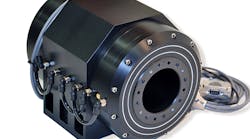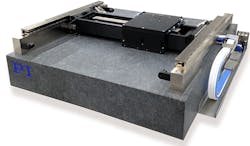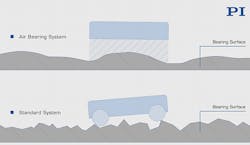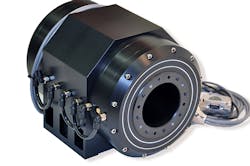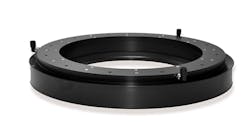This file type includes high-resolution graphics and schematics when applicable.
Friction is the Enemy
Frictionless drive and bearing technology is a prerequisite for vibration-free precision motion with nano-scale resolution, repeatability and guiding accuracy. There are several ways to achieve frictionless motion. Piezo drives and flexure guidance work well for short travel ranges typically below 1 mm. Another principle is based on magnetic levitation (magnetic bearings). These motion systems are more complex in terms of control, and designed for multi-axis motion applications. The most mature solution for long travel ranges consists of air bearings driven by electromagnetic linear and torque motors.
Air-bearing stages are rotary or linear positioners that float on a cushion of air, using one of several preload mechanisms, thus nearly eliminating mechanical contact, and in turn, wear, friction, and hysteresis effects. They deliver maximized throughput while providing higher precision than conventional bearings, especially for multi-axis motion. That’s because an XY stage can be designed with one base rather than by stacking individual stages with accumulative errors.
Benefits of Air Bearings
The most common factors supporting the use of air-bearing stages in motion-control applications are:
Frictionless High-Performance Positioning
A direct-drive motor and high-resolution encoder can position a moving carriage supported by an air bearing to within 1 nm in a linear application, or within 0.1 arc-seconds in rotational applications. The lack of friction and mechanical contact means there is minimal hysteresis or reversal error. As a result, it’s highly repeatable and ideal for many inspection and manufacturing operations, such as flat-panel inspection, semiconductor metrology, and laser machining. Air bearings virtually eliminate stiction, which improves resolution capabilities and reduces in-position “hunting“(limit cycling). In addition, position repeatability within a few fundamental encoder counts is possible. Piezo flexure guided stages can achieve similar precision, though over much smaller travel ranges. Magnetic levitation is another option.
Velocity Stability and Scanning
Inertial sensor testing, tomography, wafer scanning, and surface profiling require continuous motion at tightly controlled speeds. These types of experiments and processes are best served by air-bearing systems because the lack of mechanical-bearing elements means nothing can get in the way of smooth, controlled velocity (stability to better than 0.01%).
Very Low Error Motions Due to Surface-Averaging Effect
Air bearings offer high accuracy because not only components are manufactured with extremely tight tolerances, but also due to the air film's averaging effects (check out this video). Linear air-bearing stages have extraordinarily straight and flat travel. Pitch, roll, and yaw errors about 1 arc-second per 100-mm travel. Rotary stages achieve tilt (wobble) errors in the range of 0.1 to 1 arc-second.
Furthermore, the angular performance of an air bearing is repeatable. For manufacturing and measuring, this means a very high repeatability of the same process and the feasibility to compensate for deviations of the ideal trajectory. Considering that tolerances of current semiconductor features are approaching single-digit nanometers, and even some components in the latest automotive engines need to surpass submicron precision, this type of performance guarantees repeatable part quality and measurement reliability for applications from precision machining to optics inspection.
Travel Requirements are Greater than a Flexure Stage
Piezo-driven flexure stages and actuators can satisfy many high-precision positioning applications. However, these designs are usually limited to a few millimeters of travel. Air-bearing linear stages can be used for travels of 25 mm or more. Manufacturers such as Physik Instrumente (PI) provide linear air bearings with travels up to a meter, and can offer longer lengths with custom design.
Wobble-Free or High-Speed Rotary Motion
Rotary air bearings are stiff and are able to deliver highly precise rotary motion. Radial, axial, and wobble error motions are typically 10 times smaller than what’s possible with most mechanical-bearing solutions. Also, the rotary motion is smoother since there are no roller elements.
Minimal Maintenance
Air bearings require no regular maintenance procedures or lubrication. Moreover, the system is highly stable—without the effects of wear, performance characteristics should not change over the life of the system. There is little need for recalibrating the positioning accuracy, as can be the case when mechanical bearings wear out over time and lose guiding precision. Moving cables and hoses are often the only wear items in an air-bearing system.
Cleanliness
Because air bearings are wear-free, they generate virtually no particulates that can become airborne. This makes them ideal for cleanroom applications like optics inspection, wafer inspection, bio-pharma research, and flat-panel display inspection. For extremely clean applications, air bearings can operate using 99.9% pure nitrogen.
Precise Force Control and Sensing
Air bearings are virtually frictionless when coupled with a direct-drive motor or voice coil. They are ideal for micro- and nano-Newton-force control applications. Such applications can include pick-and-place of delicate items, materials testing, and coordinate measuring.
Non-Conductive Environments
Air bearings are not ideal for all operating environments:
• Vacuum environments: Though not impossible to operate an air bearing in a vacuum, it is challenging. Vacuum applications should generally be avoided; instead use stages based on mechanical bearings, magnetic levitation, or flexure guiding systems.
• Dirty, dusty applications: An application for air bearings is often clean environments. Avoid applications where heavy amounts of dust, dirt, debris, and fluids are present.
• Unavailable pressurized air or nitrogen: Air bearings require a continuous supply of clean compressed air or nitrogen.
Matt Reck is Air Bearing Product Line Manager at PI. He holds a B.S. in Mechanical Engineering from the University of Pittsburgh. He has extensive knowledge in design and applications of precision positioning equipment, having spent the past years working at a number of motion-control companies including Dover Instrument, Danaher Corp., and Aerotech, Inc. Additionally, as a program manager for several top engineering companies, Mr. Reck gained experience in the medical device and lab automation fields, leading the development of a wide range of products and systems.
Looking for parts? Go to SourceESB.
